Royal Navy Duke-class Frigate HMS Kent (F78) flexed her muscles after the summer break by firing up most of her weapons systems – including the rare launch of a torpedo. To prepare herself for front-line duties later this autumn, the Portsmouth-based frigate sent high explosive shells hurtling out of the main 4.5in gun to calibrate muzzle velocity (they should burst out of the barrel at more than twice the speed of sound), test fired machine guns both on the ship and her Pacific 24 sea boats, streamed out her Sonar 2087 towed array (a 1,700-metre ‘tail’ lined with hydrophones and Kent’s best ears when hunting submarines) and firing off a Sting Ray, one of two weapons she uses to take out those underwater threats.

Sting Ray is principally launched by a Merlin Mk2 (AgustaWestland AW101) naval helicopter which can also drop depth charges to deal with hostile submarines. Ideally the combination of Sonar 2087 and Sting Ray-armed Merlin should keep underwater threats at bay, well out of range of striking distance of Kent. But if not the ship carries horizontal launchers – just forward of the Portsmouth frigate’s hangar – which use high pressure to propel Sting Ray out of its tube, before the small drogue parachute deploys to slow its entry into the water. Thereafter, the torpedo – packing a 100lb explosive charge to ruin any submariner’s day – races through the water at more than 50mph until it strikes its target.

The Sting Ray is a British acoustic homing lightweight torpedo (LWT) manufactured by GEC-Marconi, who were later bought out by BAE Systems. It is propelled by a pump jet driven by an electric motor. Power is supplied by a magnesium/silver-chloride sea water battery. The propulsion method combines high speed, deep diving, agility and low noise levels. Once launched it operates autonomously, with tactical software searching for the target using active sonar and then homing in without any further assistance. The software is designed to deal with the employment of countermeasures by the target. The weapon is designed to be launched from fixed wing or rotary winged aircraft and surface ships against submarine targets.

HMS Kent is a Type 23 Duke class frigate of the Royal Navy, and the twelfth ship to bear the name, although technically she is named after the dukedom rather than the county. Sponsored by Princess Alexandra, The Hon. Lady Ogilvy (daughter of the late Prince George, Duke of Kent), Kent was launched on 28 May 1998 and commissioned on 8 June 2000. She was the first ship to enter Royal Navy service in the 21st century. The ships are named after British Dukes, thus leading to the class being commonly known as the Duke class. The Royal Navy’s Type 23 frigates will be replaced by the Type 26 Global Combat Ship and the Type 31 frigate.












